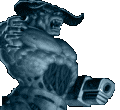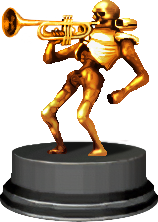-
Mordeth Award - Surprise! Released project with the longest "development time"
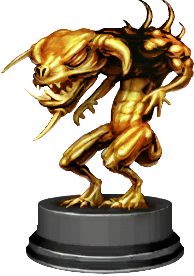
KDiKDiZD's Vanilla Technology - fraggle, RestlessRodent & Andrewj, Zokum, Mikolah, Linguica & Nine Inch Heels, entryway & the PrBoom team, et al.
KdiKdiZd is unquestionably the technological wonder of the year, which says a lot when sharing the podium with a beast like JUMPWAD. Surely its 14-year development cycle must be a fascinating story of overcoming adversity, or at least juicy dev hell drama? Well, no. When young esselfortium set out her KdiKdiZd ship upon the seas in 2008, it quickly ran aground. Despite possessing a bunch of awesome vanilla tricks and boundless talent, some design ideas had proved too ambitious, vanilla limitations too crippling, mechanisms too laborious. And thus esselfortium started Back to Saturn X instead, this project went into hibernation around 2010/11 and wasn't unfrozen until 2020.
This is everyone else's Meanwhile Story. The complex tricks and hacks of KdiKdiZd were enabled by a long string of brilliant people, their deep knowledge and indispensable tools written by them. Limitation is said to breed creativity, but the stringent limits of vanilla before it starts breaking down, corrupting memory or bombing out for whatever reason are rarely communicated well.
Chief among them is the visplane overflow crash, striking whenever a mapper dares to spread their architectural wings a bit too ambitiously. But where exactly is it, what causes it and is it still there after modifications? These questions dogged 90's mapping, and it was no different for KdiKdiZd (and later BtSX) until RestlessRodent hacked fraggle's Chocolate Doom sometime in 2008 and created ChocoRenderLimits, which relaxes crashes, reports numbers, visualises HOMs, etc. It quickly became a must-have for any ambitious vanilla-compatible project and when combined with Andrewj's Visplane Explorer plug-in for Doom Builder, mappers and testers were finally provided with a chance to debug their scenery without screaming at the DOS prompt in frustration. Other extremely useful overflow information is revealed with error pop-ups if one tests with prboom-plus in its most paranoid setting, particularly the underrated special hit overflow that crept up as a surprise threat for KdiKdiZd.
Speaking of complexity, another long-standing hurdle was the absolute maximum size of the blockmap, which led to a balancing game between a map's size and complexity. But when AV-team veteran Zokum began his deep dive into the inefficiencies of existing nodebuilders in cca mid-10's, he soon developed his own called ZokumBSP with wild optimization options that allowed to squeeze considerably more juice out of that limit. And to circle back to fraggle, in 2019 he released DEH9000, a python library that greatly facilitates DEH management and creation. Using custom weapons and enemies became easier than ever, and more economical too.
Still, all that concerns analysis, management and testing. Worthy causes, but none address the core fact that vanilla is too basic for emulating the complexities of Zdoom. That changed in November 2018, when Mikolah discovered an obscure vanilla bug further known as Mikoportal that overflows sector height and makes an actor fall through the ground endlessly without losing friction (and earned a 2019 Machaward in the process). This instantly led to the follow-up idea: emulating Boom's voodoo doll conveyors. Through experimentation by Linguica and Nine Inch Heels, a functional, (almost) reliable setup for vanilla scripting was born. Suddenly, plain old Doom grew wings and became Boom-lite in what could be dreamed up...
That is when esselfortium pressed the Assembly button and after two years of automatic, seamless & effortless process that didn't require a decade of experience with extreme vanilla mapping, KdiKdiZd was ready for shipping.
- @dew
-
Odyssey of Noises - Best original soundtrack for a Doom project
The score for Deadwing's Ozonia, much like the mapset itself, is a multifaceted work which brings together and refines artistic and sonic elements established earlier in the author's career into something new and distinct, but enlivened and informed by resonance with those older modes and moods.
The original Moonblood accentuated its desolate, fatalistic atmosphere with a score of disconsolate, downtempo post-rock material with a slight blues inflection backlit against cold minimalistic ambience, and the more experimental Exomoon was swathed in layers of gauzy, detached and oft meandering synth and ethereal jazz to compliment its slower-paced, explorative gameplay, and key selections from both of these older soundtracks appear in Ozonia, fitting in perfectly, for indeed, they're all part of the same lineage. Ozonia naturally brings a wealth of new material as well, and its musical world is livelier and more inviting, built around open, bluesy guitar work and a decidedly funky rhythmic soul, orbited by shimmering clouds of synth and pockets of symphonia to lend an element of fantasia to the surprisingly worldly core.
Peaceful and subdued, "Moonblood Shrine" is the overture used for the opening map and for narrative interludes, and as such seems to serve as Ozonia's unofficial theme, its extended synth notes and lilting strings drifting around somnolent beat only barely spurred on by a sleepily plucked bass. "The Banquet", something of a sister track used for the protagonist's return to the demon world, is equally minimalist and far more sinister in tone, with eerily murmuring acoustics and an icily reserved pace. Both pieces are deeply nostalgic in their way, seeming to reference and resonate with older chapters in the "Moon" series, while acting as bedrock on which the newer sound can grow and thrive.
The vibrant "Minds Like Magnets" is a natural standard-bearer for the album. It, too, opens on curtains of sombre ambience which recall that older time, but soon emerging from the mists of warbling synth is a funky beat that forges forward with real verve alongside a gutsy, driving bassline and jazzy key accompaniment. The groove is irresistible and immediately roots itself in the part of the consciousness that compels you to tap your toes, just in time for the guitar to fully assert itself for the first time, via a wah-pedaled, thoroughly bluesy solo of real soul to stride through, which is incredibly energizing of one's immediate actions in-game, and lends a sense of upbeat adventure and wonder to the game's often shady, ruinous locales. The wistful "Fear of Heights" reads as a mirror-reflection of this idea, with a similarly smooth, driving beat which floats poignant guitar leads between thunderheads of terse, industrial-tone riffs. My personal favorite, the swaggering "Vulcanic Dam", brings the bluesy heart evident in the other tracks even further to the fore, inflecting on it with smoky jazz elements and lush Hammond organ the perfectly compliments the weird and remote locations for which it tends to be used in-game.
It's this juxtaposition of earthy, strident melodies and rhythms of real warmth and emotive power set against the starker and more abstract backdrops of ambience that lend the album, and to a large degree the experience of the game itself, its distinct character and tone, and Deadwing explores the theme thoroughly over the course of the game. "Endless Citadela" is a somber and more instrumentally baroque track vested with arch piano tones and a very reserved beat, but retains the subtle warmth through blooming whorls of mellotron. "Hot Pressure", the album's major envoy of crunchy electric guitar, is the uptempo and unbashedly rocking, while "Skyscrapers in Void" emphasizes rhythm above all else, and seems to seek to reconcile the sheets of hazy ambience which have heretofore existed on the periphery of the compositions by bringing them into the center alongside a more overly electronic beat. The magnum opus of the soundtrack, "The Last Refuge", which fittingly accompanies the game's climax, organically blends all of the many elements touched upon earlier with a remarkable deftness, for a song that seems to look back in reflection on all of the hardships of the journey to that point while maintaining a determined and stoically uplifting forward drive, communicating that no matter how far life seems to have gone off-course, and no matter how stacked the odds, this is still a fight that you can and will win.
Like its forebears, Ozonia is set in a world rimed in dust and steeped in gloom, but as with the story of the game itself, Deadwing's music here doesn't simply ruminate on past glories, but forges ahead with a vital energy and wryly ebullient outlook all the more affecting for all of the passages of shadow and uncertainty met along the way.
-
Codeaward - Most noteworthy programming effort of the year
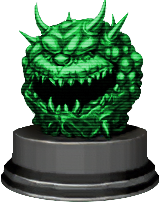 Boris Iwanski - Ultimate Doom Builder
Boris Iwanski - Ultimate Doom Builder
Some award projects aren't born overnight with a single release, but are built up over entire years. They're not on anyone's mind at first, but when namedropped, everyone in the know lightens up with an empathetic "of course". One of such is this dedication to @boris and his continuous work on Ultimate Doom Builder.
UDB, of course, builds upon previous work of giants. From codeimp (Doom Builder 1 & 2) to MaxED (GZDB), to ZZYZX aka jewalky (GZDB-fix, transition to UDB), it is impossible to frame this as one man's heroics. But over time the public itself clearly grasped that boris's submissions to UDB pushed the editor to the next level, making even hardcore vanilla enthusiasts realize that UDB is the future and anotak's Doom Builder X fork is the next to fall out of favor.
Perhaps principal among these is UDBScript, boris's own scripting language for programmatical map building tasks that facilitates or outright automates some laborous structural or detailing chores. Many a Hellforge member sighs with relief as their hyper-detailed 6-layer 3D pentagram just pops into existence. Almost equally important is the constant optimization work. DB2/GZDB's longstanding sore spot was always performance, with memory leaks galore and accompanying inevitable crashes. An expert could probably write an entire article about modern Doom coders turning away from wild hacking and embracing principles like continuous integration, but even a layman mapper will celebrate less error boxes and autosave retrievals.
UDB also became available on Linux, with the help of dpJudas and axing Direct3D. The slight downside is increased requirements for OpenGL support, following GZDoom's cutthroat model. UDB also adopted support for Doom standards and definitions old and new, MBF21 chief among them, but also including previous glaring omissions such as DeHackEd and its new age progeny (DEHEXTRA, DSDHacked). Also notably, support for external resource management, like DoomMake.
All in all, choice of editor used to be a personal preferrence, but in current year? Give up and embrace Ultimate Doom Builder.
 Matt Tropiano - DoomTools
Matt Tropiano - DoomTools
Some award projects just drop one day and they are glaringly obvious, but barely anyone knows they even exist. Like a red dwarf star that only matters for the planet that huddles in its vicinity for the heat support, the outer universe sadly ignorant of its usefulness. One of such is this dedication to MTrop and his continuous work on DoomTools.
Are you organizing a Doom project? You don't need Doom Tools, but whether you know it or not, you want Doom Tools. They are a set of low level command line utilities that help with setting up and managing a project and its resources in a software project-like manner. Doom (or Boom)'s more fascinating editing features are deeply hidden under a layer of internal formats and opaque processes, so most people throw away dreams of creating complex changes and stick with whatever basic mapping an editor allows. However these tools facilitate some of the crazy resource hacking that people mostly associate with Zdoom and its scripting.
The heart of the beast has to be DoomMake. One could make a comparison to CMake, but one crucial difference is that DoomMake isn't a lovecraftian beast that devours your soul in a labyrinthine syntax. It's a pretty damn easy way to set up a structure for your project and then assemble it from the parts. It also quickly became integrated into tools like Slade and UDB. This may seem like a lot of initial work, but if you're creating a magnum opus that will shake the world, organize yourself!
Another fantastic tool provided is DecoHack, an utility that reads a simple scripting language mimicking the unfortunate DECORATE format, and automatically converts it into a DeHackEd patch. This makes managing DEH behaviour easier by several orders of magnitude. With support of MBF21 and DEHEXTRA it is a tool that automates out a crazy amount of awful management of complex DEH setups.
Matt provides many more scripts for basic resource management (like Boom's ANIMATED definitions) that perhaps only the most hardcore mappers will ever explore, but that is only a testament to how deep the options run. For the rest of us, if you don't require pk3 files, DoomTools makes version control feasible and thus makes it possible to avoid ever again stepping on rakes such as "I lost track of who last edited this map" and "I accidentally updated the public release with a years-old beta version". For that alone, it will be an invaluable toolkit for Doom project organizers for years to come.
- @dew
-
Machaward - Most creative, unusual, or artistically compelling project of the year
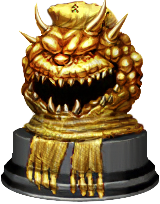
Doom RPG Port - @Erick194 & @Anarkavre
Of all the various fragments and chunks of Id Software's distinguished and oft-torrid history, possibly the least well known and least-documented is their venture into mobile games just as the mobile market transitioned from the old feature-phone J2ME "pay ten bucks on your phone bill to get an arcade clone that controls like complete shit" era to the dawn of the 99c smartphone app age. With Carmack on the tech side and his then-wife Katharine Kang heading up design and production, the majority of Id Mobile's releases were simple, enjoyable little turn-based dungeon crawlers that are well worth a play.
Sadly, the march of technology, Apple's lack of interest in backwards app compatibility and post-Carmack Id's general disinterest in repairing his little hobby projects have ultimately led to almost this entire arc of Id's history being unplayable in the modern day, outside of a single Nintendo DS release and emulating the lowest-spec J2ME versions (which lack a lot of audiovisual polish) of games that reached that platform in wildly varying-quality emulators. It's a sad state of affairs, especially considering how accessible the entire rest of Id's creative output is these days.
Thankfully, the community has a proclivity for taking "impossible" as more of a challenge than anything. Anarkavre was able to recover the seemingly-lost high-spec BREW version of the very first game of this era, Doom RPG, and Erick194 has reverse-engineered it and faithfully resurrected it on modern PCs. The end result is the best version of a forgotten obscurity, and a great starting point for delving into the stranger corners of Id's ludography.
As the name suggests, Doom RPG takes Doom back to a streamlined, simplified version of the dungeon crawlers of the early 90s, with turn-based movement and occasional stat boosts. Most of the gameplay consists of the traditional Doom staples - shooting monsters, finding secrets, navigating environmental hazards and solving simple puzzles – but all with their own little quirks that give the game its own unique personality and voice. Different monsters have weaknesses to different weapons (Lost Souls, for example, aren't big fans of fire extinguishers, while zombified dogs can be mind-controlled using collars and used as weapons/shields!), puzzles entail examining computer terminals and occasionally-eccentric NPCs for door codes, environmental hazards usually come in the form of fires to extinguish and broken doors to smash with fire axes, and secrets… actually, secrets are pretty much the same pushwall hunt as ever. The more things change...
Doom RPG is not complex or genre-redefining, but it fulfils its original purpose – quick ten-minute romps while waiting for the bus – with gusto, and the enhancements of the BREW version file off some of the rough edges with textured floors and ceilings, more animations and sound effects that aren't all just weird MIDI honks. Bringing the game back to modern players is a feat of both reverse-engineering and preservation, and it fills me with joy to see it in a state to be readily re-introduced to a fresh set of players who may have missed its weird, slightly goofy take on the series the first time around. Hopefully this preservation effort continues and we get to see similar ports and resurrections of the later games further down the line!
- Kinsie
-
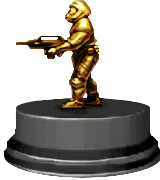 Creator of the Year - @Deadwing
Creator of the Year - @Deadwing
This year was quite a close call for the CotY -- the decision came down to the wire in December, which is as late as I've ever witnessed it myself. In the end, it goes to Deadwing, the one-person Swiss army knife behind Ozonia and its OST.
Some background: Deadwing's first megawad Moonblood already showed a penchant for imaginative, sharp-fanged combat and intricate progression, and for design inspired by staples like Doom 2 and Plutonia as well as the works of Erik Alm and Nicolas Monti. It had immersively nocturnal and apocalyptic settings, and devious setups involving lower numbers of dangerous monsters -- playing like a vision of Plutonia inflected with Deadwing's signature style. Exomoon amped up the nonlinearity and took cues from BTSX's scale and atmosphere. Its worlds had this enchanting lonely mood and an off-kilter pared-down look, combining into a feel that is hard to come by among Doom pwads; it's one of those works that captures an offbeat sense of design values, as if ported in from a different timeline. All this time he was composing his map's backing MIDIs -- indispensable for building the vibe but also mellow and restrained, willing to cede the foreground to the action and experience.
Ozonia, the third megawad in the Moonblood series (which is less a sequence you need to play in order, and more a "shared universe" deal), put it all together. While more streamlined than Exomoon, it preserves its willingness to use the occasional map primarily for ambiance and storytelling. It also upped the proficiency of the architectural craft. Ozonia, like much of Deadwing's work in general, is defined by a rare blend of intensity: extended stretches of almost mannered calmness that explode organically into vigorous, deadly fights -- a contrast wielded skillfully for pacing's sake.
While I could go on longer about Ozonia's compelling aesthetics, the year had no shortage of creators who delivered in that sense, so let's discuss some characteristics more particular to Deadwing among the candidates.
Authors in the CotY discussion invariably have shown a stellar command of some facet of the experience. In Deadwing's case, that is combat kinetics: his setups are consistently satisfying and dynamic, which flows from a strong grasp of important encounter design concepts. Here's just a sampling:
-
Arena shape: Oddball arena shapes -- think less flat circles and squares, more Ls, Vs, #s, organic caverns, constructs stitched together from more than one shape or emerging from the way one area borders another, etc. -- tend to produce more interesting encounters. Among other things, they impede the player from running effortless loops, which in turn creates more reactive, chaotic interactions between the player and monsters.
-
A nuanced model of pacing: The concept of pacing is not restricted to high intensity vs. moderate vs. low; each type of intensity can be differentiated further by the nature of the action within it. Quieter stretches of Ozonia sometimes use very sparse action to accompany parkour or sight-seeing or swimming in the ambiance -- but sometimes the minimalist combat itself is the centerpiece. By shifting between different "flavors" of engagement, it can sustain its calmer downbeats for longer before something more dramatic absolutely has to happen.
- Staging: How fights are presented matters. In Ozonia you get the usual mix of teleport ambushes and closet traps, but also a bevy of other reveal types, like a tendency for monsters to open doors, or lurk around corners and in shadows in clever ways (it's so easy to do this in a "two zombies behind both sides of a doorway" way that gets predictable very quickly, a pitfall Ozonia avoids). There is a particular sense of theatrics and even rhythm that its setups have by design, which help fashion its drifting, desolate mood.
He obviously did not invent these principles, but neither did this honor's previous recipients invent ideas like "a compelling aesthetic experience." Putting them together so well, backed by an individualistic gameplay philosophy, is the stroke that counts. Personally I love the slaughter and lite-slaughter action that is popular these days, and I also don't mind relentless intensity -- but I'm just as much a fan of having a broad range of good wads to play that hit different bases. So when it comes down to it, "something off the beaten path, done really well" is my favorite archetype, and Deadwing's work, which has a lot to say about how minimalism can also be pulse-poundingly fun and a treat for the senses, deserves that label in spades.
- @rd.
-
Arena shape: Oddball arena shapes -- think less flat circles and squares, more Ls, Vs, #s, organic caverns, constructs stitched together from more than one shape or emerging from the way one area borders another, etc. -- tend to produce more interesting encounters. Among other things, they impede the player from running effortless loops, which in turn creates more reactive, chaotic interactions between the player and monsters.
